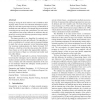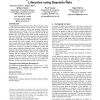206 search results - page 19 / 42 » Predicting Effectiveness of Automatic Testing Tools |
OOPSLA
2010
Springer
14 years 8 months ago
2010
Springer
Testing is among the most effective tools available for finding bugs. Still, we know of no automatic technique for generating test cases that expose bugs involving a combination ...
BMCBI
2004
14 years 9 months ago
2004
Background: The prediction of ancestral protein sequences from multiple sequence alignments is useful for many bioinformatics analyses. Predicting ancestral sequences is not a sim...
BMCBI
2005
14 years 9 months ago
2005
Background: With the exponential increase in genomic sequence data there is a need to develop automated approaches to deducing the biological functions of novel sequences with hig...
INFSOF
2007
14 years 9 months ago
2007
An important decision problem in many software projects is when to stop testing and release software for use. For many software products, time to market is critical and therefore ...
BMCBI
2010
14 years 10 months ago
2010
Background: Determining beforehand specific positions to align (anchor points) has proved valuable for the accuracy of automated multiple sequence alignment (MSA) software. This f...


